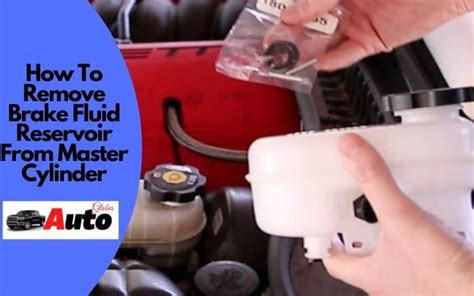How To Remove Brake Fluid Reservoir From Master Cylinder
Ronan Farrow
Apr 02, 2025 · 3 min read

Table of Contents
How to Remove a Brake Fluid Reservoir from a Master Cylinder
Removing a brake fluid reservoir from a master cylinder might seem daunting, but with the right tools and a methodical approach, it's a manageable task. This guide will walk you through the process, providing tips and precautions to ensure a smooth and safe operation. Remember, safety is paramount when working with your vehicle's braking system.
Essential Tools and Materials:
Before you begin, gather the necessary tools. Having everything ready will streamline the process and prevent interruptions. You'll need:
- Wrench(es): The specific size will depend on your vehicle's make and model. Check your vehicle's repair manual for the correct size. You might need multiple sizes.
- Socket Set: A socket set with extensions can provide better access in tight spaces.
- Gloves: Protect your hands from brake fluid, which is corrosive.
- Rags or Shop Towels: Essential for cleaning up any spills.
- Container: A container to catch any remaining brake fluid.
- Vehicle Repair Manual: This provides vehicle-specific instructions and diagrams.
Step-by-Step Removal Procedure:
The exact procedure might vary slightly depending on your vehicle's year, make, and model. Always consult your vehicle's repair manual for specific instructions. This guide provides a general overview.
1. Preparation is Key:
- Safety First: Always work in a well-ventilated area. Brake fluid is toxic and can be harmful if ingested or inhaled.
- Park Safely: Ensure your vehicle is parked on a level surface and the parking brake is engaged.
- Disconnect the Battery: Disconnecting the battery's negative terminal is a crucial safety precaution to prevent accidental electrical shorts.
2. Locate and Access the Reservoir:
- Identify the Reservoir: Locate the brake fluid reservoir on the master cylinder. It's usually a plastic or metal container attached to the top of the master cylinder.
- Access Points: Determine how the reservoir is secured to the master cylinder. This may involve clamps, bolts, or other fasteners.
3. Disconnect the Lines and Components:
- Brake Lines: Carefully inspect the brake lines connected to the reservoir. Note their placement and how they connect. Disconnect them gently and carefully.
- Vacuum Lines: If there are any vacuum lines connected to the reservoir, disconnect them as well. Note their locations.
- Electrical Connections: If there are any sensors or electrical connectors, carefully disconnect them.
4. Remove the Reservoir:
- Remove Fasteners: Once all the connections are disconnected, carefully remove any fasteners holding the reservoir in place.
- Careful Removal: Gently lift the reservoir away from the master cylinder. Be mindful of any potential obstructions.
5. Clean Up:
- Clean Spills: Clean up any spilled brake fluid immediately. Use rags or shop towels and dispose of them properly.
- Inspect Components: Inspect the reservoir, master cylinder, and surrounding components for any damage or leaks.
Reinstallation:
Reinstalling the brake fluid reservoir is essentially the reverse of the removal process. Remember to:
- Double Check Connections: Ensure all lines and connectors are properly reattached.
- Bleed the Brakes: After reinstallation, it's crucial to bleed the brakes to remove any air that might have entered the system during the process. This is a critical step to restore proper braking performance. Consult your vehicle’s repair manual for the correct bleeding procedure.
Important Considerations:
- Brake Fluid Type: Use only the correct type of brake fluid specified in your vehicle's owner's manual. Using the wrong type can damage your braking system.
- Professional Assistance: If you're uncomfortable performing this task, it's best to seek professional assistance from a qualified mechanic. Improperly servicing your brakes can compromise your safety.
By following these steps and taking necessary precautions, you can successfully remove and reinstall your brake fluid reservoir. Remember to always prioritize safety and consult your vehicle's repair manual for specific instructions.
Featured Posts
Also read the following articles
| Article Title | Date |
|---|---|
| How To Store A Boat Outside In Winter | Apr 02, 2025 |
| How To Test Vss Sensor | Apr 02, 2025 |
| How To Relieve Neck Pain From Roller Coaster | Apr 02, 2025 |
| How To Trim Rug Pad | Apr 02, 2025 |
| How To Refurbish Aluminum Wheels | Apr 02, 2025 |
Latest Posts
-
How To Winterize Rv Without Antifreeze
Apr 03, 2025
-
How To Winterize Rv Washer
Apr 03, 2025
-
How To Winterize Jet Boat
Apr 03, 2025
-
How To Winterize Camper With Air Compressor
Apr 03, 2025
-
How To Winterize An Rv Ice Maker
Apr 03, 2025
Thank you for visiting our website which covers about How To Remove Brake Fluid Reservoir From Master Cylinder . We hope the information provided has been useful to you. Feel free to contact us if you have any questions or need further assistance. See you next time and don't miss to bookmark.
